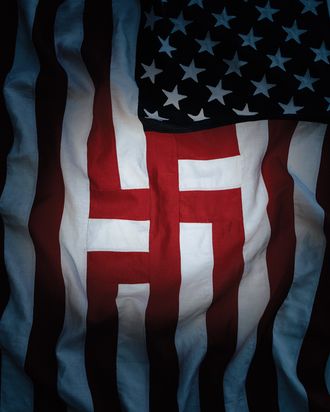
On August 12, when a coalition of white-nationalist groups scheduled a rally in Charlottesville, Virginia, it was intended to demonstrate their strength. The actual event instead demonstrated the opposite, at least in its initial effects. Despite drawing upon supporters nationwide, attendance topped out in the mid–three figures. The attacks on counterprotesters that killed one and injured dozens horrified the nation. But what transmuted the failed rally into a rousing success was the response by President Trump, who, in a pair of rage-addled rants before the news media, drew the white-nationalist movement into the Republican coalition and gave it a legitimacy it could never have dreamed of.
The rally’s marchers were summoned by posters depicting marchers in Confederate uniforms with Nazi eagles; they chanted “Blood and soil!” and “Jews will not replace us!” Still Trump insisted, “Not all of those people were neo-Nazis, believe me”; some of them were “very fine people.” He parsed the ideological definitions presented to him. (“When you say ‘the alt-right,’ define ‘alt-right’ to me. You define it.”)
It is hardly novel for Republicans to get mixed up in racism. Whatever the abstract merits of small-government conservatism, its political prospects have long required the exploitation of white racial resentment. What is new and even shocking is the intermingling of Republican politics with open white supremacy.
The GOP’s “southern strategy,” from Barry Goldwater’s states’-rights-based opposition to civil-rights law to Ronald Reagan’s story of the “strapping young buck” on food stamps, operated at a symbolic remove. Racism was the unmistakable subtext, but explicit white supremacy was politically verboten. Even while they won votes by convincing white Americans that government was a vehicle for transferring resources to undeserving minorities, Republicans kept the Ku Klux Klan at arm’s length. Nazism, too, had no valence in electoral politics, and Nazis have served as the ultimate representation of evil in American culture for decades. Nazis served as villains in countless movies — Raiders of the Lost Ark, The Blues Brothers — that were not seen as remotely political.
The political imperative of severing modern conservatism from outright white supremacy is (or at least was) serious enough that a long-standing genre of right-wing polemic is dedicated to insisting that fascism and racial segregation have no ideological relationship to the political right at all. Five years ago, Kevin Williamson argued in a National Review story that it was an “outright lie” and “utter fabrication” to believe that the Republican Party had “switched places” with the Democrats in “protecting the rights of black Americans.” Jonah Goldberg’s 2008 book, Liberal Fascism, and Dinesh D’Souza’s new one, The Big Lie, both define Nazism as a left-wing ideology rather than a right-wing one. Trump has rendered these rationalizations absurd. D’Souza’s argument was particularly ill-timed: He published his book dedicated to the case that Nazis are a movement of the left less than two weeks before actual Nazis held a national rally called “Unite the Right.” He explained away this development by seizing on a rumor that one of the rally’s organizers, Jason Kessler, was “an Obama guy,” thus concluding that “the whole rally may have been staged to feed the mainstream media’s big lie that racism & fascism are on the right.” (The “evidence” of Kessler’s ties to Obama consisted of rumors on white-nationalist message boards and a crude Photoshop of Kessler’s head onto the body of Oval Office visitor Will Ferrell.)
Trump almost certainly does not believe Jews are masterminding a global plot to pollute the white race. (Yes, it would be nice if the previous sentence didn’t need the almost.) In 1999, when he was mulling a presidential run with the Reform Party, he assailed Pat Buchanan, a rival candidate, as a “Hitler lover.” His overriding ideology is narcissism in general, and, in particular, he has a tendency to gravitate toward anyone who praises him while lashing out at any critic. His initial foray into Republican politics, as a prominent purveyor of the birther hoax, gave him a market share of the party’s most racist voters. As Trump’s advisers steered him toward nativist themes, white nationalists glommed onto his candidacy, which they saw as an entry point into a two-party system that had previously ignored them completely. Their love of Trump made Trump love them back. The process of running for and becoming president seems to have made Trump more racist.
In that sense, he mirrors the drift of the Republican Party, which is not to excuse its leaders for their increasingly audible dog whistles but merely to explain how it is possible that the party’s elite spent a week in the summer of 2017 clarifying their relationship to Nazis and Klansmen. The famous “autopsy report” Republicans conducted following the 2012 election insisted that the country’s growing diversity required the party to expand its appeal to nonwhite Americans; 2016 proved that assessment premature, as disillusionment with Hillary Clinton and a favorable electoral map allowed Trump to win what he and his advisers still call a “landslide” victory with a margin of negative-2 percent.
Still, the Trump presidency has only accelerated the ticking of the demographic clock. A majority of the public as a whole disapproves of Trump’s remarks. The mainstream news media, most Republican Party professionals, and business and military leaders have all treated the president’s defense of the “Unite the Right” march as an extinction-level event. But, as with most things, the party base has mostly stuck with the president — two-thirds of Republicans approve of what he said. The departure of Steve Bannon from the White House will change very little, given that the president has proved utterly unadvisable. Trump and his party continue to creep ever closer to a destination that once seemed unthinkable. And three and a half years of his term remain.
Flag design by Christopher Griffith.
*This article appears in the August 21, 2017, issue of New York Magazine.






























